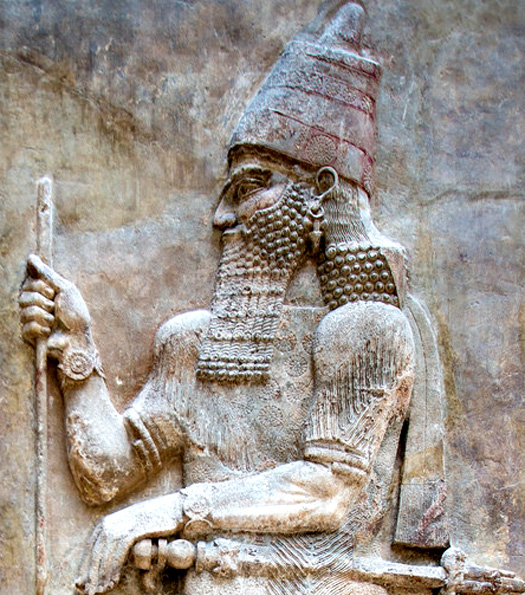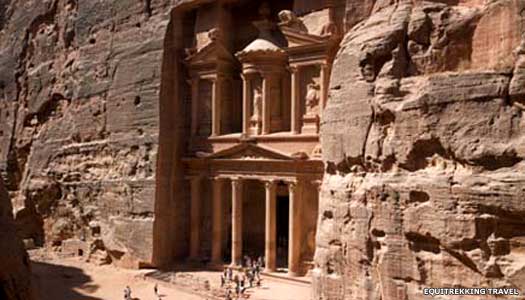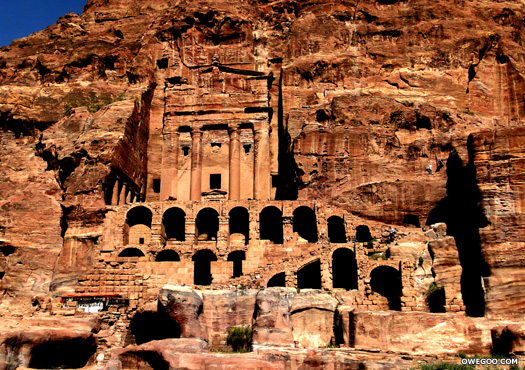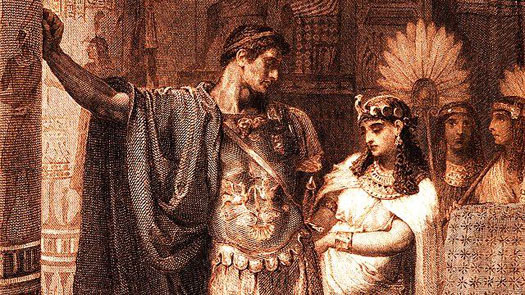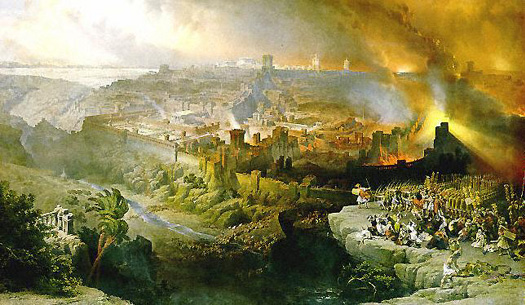
| NABATAEA / NABATU Prominent during Rome's occupation of Judea were a people known as the Nabataeans. They are famous to much of the world for their creation of Petra (the Greek word for 'rock'), a unique city which was carved into the rose-red rocks of present day Jordan and accessed via a narrow one kilometre gorge known today as the Siq. The city combines eastern artwork with the Hellenistic culture which was still prevalent in the Levant of the time.
The Nabataeans probably originated as a nomadic Arabic tribe known as the Nabatu. They emerged in the seventh and sixth centuries BC, migrating into the region which today forms parts of Jordan and northern Saudi Arabia. The Assyrians knew them as allies of the Kedarites, although little else has been recorded about them in their early days. They spoke an early form of Arabic, and were often labelled simply as Arabs by Greek and Roman writers.
As their ancestor figure, the Nabataeans claimed Nebajoth or Nebaioth, one of the twelve sons of Ismael (Ishmael), himself a son of Abraham. The Kedarites also claimed descent from a son of Ismael. The truth of the claim is debatable, of course, as Abraham's immediate descendants are claimed as the founding fathers of many of the kingdoms which existed on the borders of ancient Israel. The Old Testament does mention the Nebayot, however, classing them primarily as shepherds. The respected Jewish historian Josephus repeated the claim, and provided further detail which rightfully belongs to the period of the Nabataean kingdom (from 169 BC).
(Information by Peter Kessler, with additional information by Lisa Elliot, from Jewish War & Jewish Antiquities, Flavius Josephus, from Petra and the Lost Kingdom of the Nabataeans, Jane Taylor (2001), and from External Links: Nabataea.net, and Livius.org.)
704 - 701 BC :
With the death of Sargon II, many of the former Assyrian subject states rebel, especially Chaldaeans and neighbouring groups. Amongst the rebels are listed the Hagaranu (possibly the descendants of Hagar, the mother of Ismael), the Nabatu (very possibly the descendants of Nebayoth, the eldest son of the same Ismael), and the Kedarites (descendants of Ismael's second son). According to the records, these tribes flee from Assyria into the Arabian Desert and cannot be conquered. The use of 'tribes' here may be misleading. The Kedarite kingdom at least is already in place, so these may be captured and transported slave groups instead. With the recapture of Babylon a priority, it takes the Assyrians until 701 BC to get around to quelling similar rebellions in Judah and the Phoenician states.
Sargon II usurped the Assyrian throne, seizing it from the last of the Ashur-Rabi monarchs, but he brought with him Assyrian resurgence and a drive to expand the empire fl 650s BC :
Natnu : Chief of the Nabatu.
664 - 663 BC :
With the sacking of Thebes, the Assyrians complete their conquest of Egypt, making it a vassal state with subject pharaohs. It could be Natnu who leads the Nabatu (the early Nabataeans) in fighting against Assyria around the same time. King Ashurbanipal records conflict against the 'Nabaiateans' of Arabia. Bizarrely, perhaps, there is a school of thought which refuses to connect Nabaiateans of Arabia with Nabataeans of Arabia. The chances of two tribes having such similar names is incredibly small, and if they do, then the chances of them having a shared root is extremely high.
649 BC :
Shamash-shumi-ukin of Babylon rebels against his brother in the Assyrian kingdom. Ashurbanipal soon besieges Babylon, bringing it back into the empire. Rebellions in support of Babylon by the Kedarites and Nabatu are also put down, possibly prior to Babylon's recapture. It takes two years of direct rule before a puppet ruler of Babylon is placed on the throne, while the son of the Nabatu chief is declared leader of their people (his father's fate is not recorded).
c.649 BC - ? :
Nuhuru ibn Natnu : Son.
after 539 BC :
During the Persian period, Moab disappears from the historical record. Although their precise fate is unknown, they may indeed be migrating northwards along with the Edomites to claim the emptied lands of northern Canaan. Their departure allows tribes of Arabs to make a similar migration out of Arabia, including the Kedarites and then the early Nabataeans, allies of the Ammonites. This movement could be seen as an expansion of the territory they have held during the constant fighting against Assyria, rather than a migration.
However, the initial flourishing of the Nabatu in history is relatively brief. In the same century they apparently disappear from records, as little more is heard of them until they resurface as the Nabataeans in the second century BC. During that time they are busy developing a culture and society that creates the stone city of Petra in the sixth century BC, probably during that brief flush of enthusiasm and creativity that follows their arrival in the region. This flourishes from the third century onwards, as the Nabataean trading kingdom becomes prosperous.
312 BC :
A cuneiform inscription records the defeat of a Syrian army by the Nabataeans. The Greeks of Argead Syria, under the command of Demetrius, son of the Antigonid ruler, Antigonus Monophthalmus, attempt to attack and plunder Nabataeans living in Edom on two occasions, but on one of those occasions the Nabataeans choose to buy him off with expensive gifts.
The cuneiform tablet records the existence of the Nabataeans, one of the few mentions of them as later records were largely paper/papyrus-based, written in Aramaic or Greek 259 BC :
The Zenon papyri mention that the Nabatu are trading Gerrhean and Minaean frankincense, transporting them to Gaza and Syria. They transport their goods through the Kedarite centres of northern Arabia, Jauf, and Tayma. Early Nabataean pottery can also be found in locations along the Persian Gulf, and around what is now coastal Saudi Arabia and Bahrain. References from around this period also mention the Nabatu as living along the western edges of the Arabian Peninsula and in the Sinai. These Nabatu are also pirates who sail the Red Sea plundering trading vessels. They go on to establish bases in a number of seaports, including the port city of Aila (modern day Aqaba), which is only some one hundred and twenty kilometres from Petra.
Kingdom
of Nabataea :
The Nabataean kingdom arose in the ancient territory of Edom during a period of depressed fortunes for the two regional empires, the Seleucids and the Ptolemies. Essentially traders, the Nabataeans had settled down since their early days of fractious relations with the Assyrian empire, and the establishment of their kingdom probably predates 169 BC by several decades, if not a century. Unfortunately no ancient writer documented any such establishment so a true founding date is unavailable. Harithath I is typically classed as being the first king.
In the second century BC the Nabataeans certainly did re-enter the historical record, by expanding their territory into ancient Moab where they dealt extensively with the Greek, Roman and Egyptian empires. Their kingdom now stretched from Damascus (albeit briefly) to the Red Sea, and from Sinai to the Arabian Desert. This is backed up by Josephus, who stated that the Nabataeans lived across the entire land stretching from the Euphrates to the Red Sea. He referred to this area as 'Nabatene', the land of the Nabataeans, and went on to say that it was the Nabataeans who conferred their names on the Arabian nations. In favour of his statements being accurate is the likelihood that he would have been able to speak to the Nabataeans directly.
Their capital city of Petra was founded some time in the sixth century BC, although a settlement had existed in the area (which is in present day Jordan) since perhaps the eighteenth century BC. The Nabataeans themselves knew it as Raqmu (or Rekem) - Petra is a Greek word which means 'rock'. The city flourished as an economic and religious centre from the third century BC, surviving as such for about four hundred years. Its site, in the Shera Mountains, was an important crossroads for Arabia, Egypt and Syria-Phoenicia. As recently as 2010, new surprises were being discovered there when experts from the Courtauld Institute in London restored two thousand year-old Hellenistic-style wall paintings, removing centuries of soot and layers of grease to reveal exquisite artwork that rivals the Roman paintings of Herculaneum.
The names of kings are shown first in their Arabic form wherever this is possible. These are followed by the Hellenised version because Greek culture remained dominant at the time of the kingdom's founding. Greek and then Roman records remain the best sources for anything involving the Nabataeans.
(Information by Peter Kessler, with additional information from Jewish War & Jewish Antiquities, Flavius Josephus, from A History of the Jews, Paul Johnson (1987), from A Report on Arabia Provincia, G W Bowersock (The Journal of Roman Studies, Vol 61, 1971), and from External Links: Appian's History of Rome: The Syrian Wars, and Nabataeans, both at Livius.org.)
169 - c.150 BC :
Harithath I / Aretas I : 'Tyrant of the Arabs' & 'King of the Nabatu'.
c.165 BC :
Idumaea gains its freedom from Seleucid rule, probably at the same time as Judea achieves its own independence by fighting a brief but successful struggle against the Seleucids. By this time, the Nabataeans already control the Kedarites to the south.
Petra was founded in the sixth century BC on the site of an earlier but far more minor settlement, and grew to its full magnificence as the Nabataean capital in the second century BC c.150 - ? BC :
Malichus? (I) : Name uncertain. Noted by Josephus as king about 145 BC.
146 - 145 BC :
The son of Demetrius, Demetrius II, begins a revolt against Alexander Balas, ruler of the Seleucid empire. Demetrius' general, Apollonius, is defeated by Jonathan Apphus of Judea, but Alexander's position grows increasingly tenuous. He attempts to flee at the start of 145 BC but is killed by Nabataeans.
? - 110 BC :
ar-Rabil? / Rabbel (I) : Name uncertain.
110 - 96/92 BC :
Harithath II / Aretas II : 'Erotimus, King of the Arabs' noted by Alexander Jannĉus.
96/2 - c.88/6 BC :
Ubaidah I / Obodas I : Son. 'King of the Arabs'.
93 - 90 BC :
A number of Nabataeans are forcibly converted to Judaism by the Hasmonaean king, Alexander Jannĉus (Jannaeus). Once he has safely put down a local rebellion he invades and occupies the Nabataean towns of Gilead and Moab. There he imposes tribute although the amount is unknown. Obodas I has prepared for such an attack and is soon able to respond by ambushing Alexander's forces near Gaulane. The Judean army is destroyed in 90 BC and Obodas is able to gain control of the Hauran and Jebal Druze.
c.88 - 87 BC :
ar-Rabil II (I) / Rabbel II (I) : Brother. Reigned for less than a year.
87 BC :
Seleucid ruler Antiochus XII attacks the Nabataeans from 87 BC, intent on recapturing former imperial territory that has gradually been lost to them. However, the empire is far from being the power it had once been, so that although he kills ar-Rabil I, the Nabataeans resist his advance.
c.87 - 62 BC :
Harithath III / Aretas Philhellen : Brother.
87 - 85 BC :
Harithath III makes an immediate impact, conquering Ammon from the tyrant of Philadelphia and southern Syria from the Seleucids. In 85 BC, the inhabitants of Damascus invite the Nabataean king to become their ruler. He adopts the Greek epithet, 'Philhellen' ('friend of the Greeks') to show his credentials as a minor but important power in the region.
The Nabataeans developed their land in the Negev Desert, making it liveable by building cisterns and damns to trap water and carving out terraces and, eventually, palaces 64 - 62 BC :
Pompey conquers Syria, including Ammon, making Syria a Roman province in 63 BC. The following year, Pompey's general, Scaurus, devastates the area around Petra but is unable to capture the city, partially because he has run out of supplies. The Nabataeans apparently buy their freedom by paying tribute and, remarkably perhaps, retain Damascus. Just as they had managed to avoid assimilation into the Seleucid empire, now they are keeping Rome at arm's length.
62 - 59 BC :
Ubaidah II / Obodas II
59 - 30 BC :
Maliku I (II) / Malichus I (II)
32 - 31 BC :
Very soon after being placed on the Judean throne by Rome, Herod the Great is supported by Cleopatra of Egypt when launching an attack on the Nabataeans. His well-organised troops, which include a large mounted force, plunder the kingdom and occupy Dium. The Nabataean forces amass near Canatha in Syria, but are attacked and routed. With Cleopatra now troubled by Herod's success, General Athenion of Egypt sends a force of Canathans to the aid of the Nabataeans, and this enlarged army is able to crush Herod's army. It flees to Ormiza but Herod returns the following year to once again overrun the kingdom.
The last independent Hellenic ruler of ancient Egypt, Cleopatra VIII is perhaps one of history's best-known figures, thanks to her involvement in Rome's affairs in the lead up to the formation of the empire, and her two great romantic match-ups, with Julius Caesar and Marc Antony 30? BC :
An earthquake hits Judea, seemingly soon after the conflicts of 33-32 BC. Herod offers the Nabataeans a peaceful continuation of his domination of them but they choose to rebel. They invade Judea, but Herod immediately crosses the River Jordan to Philadelphia (modern Amman) and, once he has sighted the Nabataean forces, he attacks their outer while they are holding off from battle. The confused Nabataeans are defeated and retreat into a defensive camp. Herod lays siege, with some defenders surrendering before the remainder are refused surrender terms. The Nabataeans lose the battle and effectively remain under Herod's domination.
30 - 9 BC :
Ubaidah III / Obodas III : 'The Divine Obodas' & 'Zeus-Obodas'.
9 BC - AD 40 :
Harithath IV / Aretas Philopatris : 'King of the Nabatu, who loves his people'.
AD 9 - c.16 :
Huldo / Chuldu : Wife and queen. Co-ruler.
AD 40 :
Harithath IV's reign sees the greatest of Petra's tombs created, as well as possibly adding the great High Palace. By this time, under the terms and protection of the Pax Romana, the Nabataeans have become wholly sedentary and civilised, offering Petra as a cosmopolitan place for trade, albeit somewhat diminished trade now that routes have been opened up with the east.
40 - 70 :
Maliku II (II) / Malichus II (III) : Son.
c.40 - 60 :
Shakilat / agīlat : Wife, sister, and queen. Co-ruler and also regent for her son.
67 :
Maliku sends an army to help the future Roman emperor, Vespasian, in the siege of Jerusalem in Judea. Maliku later loses control of Damascus but retains the territory to the east and south-east of it. Now that the Nabataeans have made the transition from nomad to sedentary, they have become targets for other nomads. Tribes from Arabia begin to attack the southern regions of the kingdom, penetrating into the Negev where they destroy Oboda and forts on the Petra-Gaza road.
The Nabataeans are perhaps unknown for the part they played in the siege of Jerusalem in AD 67-70, however minor that part may have been, with their support going to the Romans against their long-standing regional rival 70 - 106 :
Ar-Rabil II (III) / Rabbel Soter : Son. 'He who gives life and salvation to his people'.
c.71 - 90 :
Gamilat : Wife, sister, and queen. Co-ruler.
88 :
An inscription of this date gives ar-Rabil II his title, 'Soter' or 'Saviour', perhaps because he has concentrated on subjugating the Arab tribes which have recently caused the kingdom some trouble. He also lays the basis for dry-farming and horse rearing in the region.
However, with Rome in charge of Judea to the north and Egypt to the west, trade between the two is increasingly carried out via the Mediterranean, bypassing the trade route through Nabataea. The kingdom suffers badly from the decline of the 'Incense Route'. When the end comes, the Nabataeans offer no real resistance.
106 :
Maliku III (IV) / Malichus III (IV) : Son? May have claimed the throne only, but did not rule.
106 :
Nabataea is officially subsumed within the Roman empire, becoming the capital of the province of Arabia Petraea. The principle reason is that Emperor Trajan wants better protection of the road from Damascus to Alexandria. With the Nabataeans writing in Greek from the third century AD and converting to Christianity by the fifth century, Petra remains inhabited during the subsequent Byzantine period, but has already greatly declined in importance.
The Arab invasion of the seventh century destroys any remaining Nabataean identity, incorporating them into the new Islamic empire. The Crusaders construct a fort there in the twelfth century but this is soon abandoned, leaving Petra to the local peoples who completely abandon it by the fourteenth century. The city is largely forgotten until it is rediscovered by the Swiss explorer, Johann Ludwig Burckhardt in 1812. By the twentieth century, the region is part of Hashemite Transjordan.
Source :
https://www.historyfiles.co.uk/ KingListsMiddEast/ |
